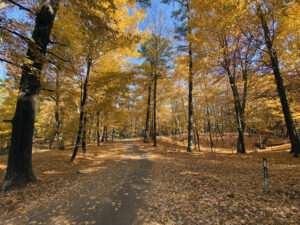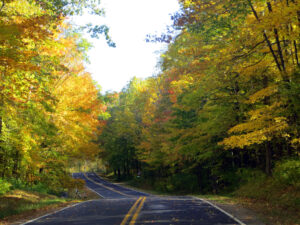
Fall colors set a trail at Sheboygan’s Kohler-Andrae State Park ablaze in 2021. / Photo Credit: Bill McNee, Wisconsin DNR
By Art Kabelowsky, DNR Forest Health Outreach and Communications,
Fitchburg; Arthur.Kabelowsky@wisconsin.gov, 608-335-0167
Once again, it’s time for nature’s majestic paintbrush to spread its magic across Wisconsin.
Many of the state’s trees have begun to show off their amazing fall colors, brightening the view for state residents and visitors everywhere – from the restful resplendence of our urban areas and state properties to the drive-by dazzlement of our tree-lined country roads.
“It’s a brilliant and colorful display,” said Scott Lyon, leader of the Wisconsin Department of Natural Resources Forest Products team. “The Badger State is home to many deciduous hardwood species which change colors and lose their leaves as the seasons change, including maple, oaks, hickories and aspen.”
The annual process starts in late September in the north and slowly spreads its swaths of color southward. Leaves show off blazing reds, deep oranges and vivid yellows, all created through natural processes based on biology and chemistry. (For those interested in the science behind fall colors, the DNR provides a detailed guide.)
And if you just want to take in the show? Whether you’re in the big city or way out in the countryside, know that October is the month for Wisconsin’s fall colors to steal your breath away.

Fall colors shine at Southview Park in Neenah in 2022. / Photo Credit: Bill McNee, Wisconsin DNR
Some need to travel only as far as their living room window to bask in the brilliance. Others plan a special trip to hike, bicycle or drive through their time-tested favorite vistas. (Pro tip: Impulsive decisions often work just as well.)
Travel Wisconsin provides a regularly updated online fall colors guide to steer leaf-chasers in the right direction.
A great place to start a fall adventure is by choosing from the plentiful list of Wisconsin’s state forests, parks, recreation areas and trails. Many state forests were formed around watersheds, offering visitors a way to admire fall colors while taking part in other recreational activities along Wisconsin’s serene lakes, rivers and streams.
For a deeper dive, Lyon said, the DNR’s Forest Inventory and Analysis program conducts Wisconsin’s tree census with valuable information about forests in the state, including which species are prevalent in specific locations.
The Travel Wisconsin website also provides a list of 11 scenic drives visitors can take to experience Wisconsin’s fall colors.
For those interested in knowing more about forests than simply the color show, experts around the DNR’s Applied Forestry Division have provide their unique points of view:
Reforestation: Consider Fall Colors
When landowners plant trees and shrubs, their plans generally give precedence to aspects such as wildlife habitat, forest products, mitigating wind erosion, stopping blowing snow or creating a privacy fence. So, a tree’s fall colors are not always at the front of their minds.
But the chance to view fall colors has become one of Wisconsinites’ richest and oldest fall traditions. As Joseph VandeHey and Jeremiah Auer of the DNR’s Reforestation program point out, some of the best species to choose for tree planting also produce some of the most interesting colors:
Aspen: The small, clove-shaped leaves turn a warm yellow, but equally interesting is the clacking sound they make as fall winds blow through them.
Red maple: Usually one of the earliest to turn, these raggedy leaves go from a rich green to bright red, that almost glow as sunlight hits them.
Red oak: These deep green, waxy leaves turn a dark crimson. The sturdy leaves are a favorite for children that enjoy jumping into leaf piles. They are strong and stack well.
Sugar maple: Their brilliant green hues change from orange to a vibrant yellow. Even after they fall, they tend to hold their color for days.
White oak: The deep forest green leaves change to a warm yellow or brown. Plus, they hang on to the tree deep into the fall and winter. Offering a contrast to the gray skies and white snow-covered ground.
White pine: Although conifers don’t shed their leaves in fall, many do jettison their 2-year-old needles. The bright yellow spears will fall to the ground and cover everything that doesn’t move.
Tamarack: Our only native conifer that drops its needles in the fall, the golden hue of a tamarack bog is a site to behold. And while it doesn’t last long – the needles fall quickly – for a few days, the forested wetlands of the north are brilliant.
Forest Health: Colors Tell Tales
It’s impossible to predict precise dates for fall colors from year to year. There’s one big reason – fall weather – but other factors can contribute, too. And those factors can also provide hints about the health of the forest.

Fall colors begin to take hold in a hardwood stand in northern Ozaukee County. / Photo Credit: Bill McNee, Wisconsin DNR
“True fall color is a little less related to forest health and more related to weather,” said Linda Williams, a DNR Forest Health program specialist based in Woodruff.
“If trees are healthy, they’ll have a better chance of displaying good fall colors. But true fall colors are more a response to nice warm days, cool nights and a good amount of rain.”
In 2024, the spring and early summer was exceptionally wet and cool. In September, the weather moved to the dry side. Williams said that back-and-forth has impacted some trees, particularly aspen, in her area of northeast Wisconsin.
“We had such a wet spring this year (and) that promoted a lot of leaf diseases, particularly in our aspen,” Williams said. “When a leaf has fungal disease, it’s not going to produce good fall color.
“Many of our aspen trees – at least 30 percent, maybe higher – had leaf disease early in the spring, and they recently dropped their leaves, and they were brown and crispy.”
Even though the weather has been dry in northeast Wisconsin, temperatures have been good, so Williams believes that the region’s display of fall color will still be worth a trip.
Silviculture: Climate And Color
Brad Hutnik is a DNR forest ecologist and silviculturist (a professional in the science and art of planning and managing forests on a large scale). He spends a lot of time these days considering the short-term and long-term effects of climate change on forests all over Wisconsin.
“Foresters, we think in 100-year terms,” Hutnik said. “When we think of fall colors, we might think of what colors our grandkids and their kids will see, not necessarily us.”
Silviculturists and other scientists have built a web site that gathers information and projections on climate change. Among its offerings are climate change field guides for forests in southern Wisconsin and northern Wisconsin. These guides are meant help foresters and other landowners select the best species to plant on their specific lots.
“We shouldn’t assume certain species to the north might (continue to) do poorly, and species to the south are going to do well,” Hutnik said.
While weather can affect fall colors in a specific area from year to year, climate is a wider-ranging and permanent factor.
“Climate change is scary, but oftentimes, with color it’s just one of lots of different factors,” Hutnik said. “Sometimes the changes we make for climate change might have very small results in the short term but bigger in the long term. … Color and aesthetics are a piece of the bigger puzzle.”
Hutnik said his favorite spots to view fall colors include the Forest Exploration Center in Wauwatosa and the tower at Blue Mound State Park. He adds that any drive, bicycle ride or hike in the Driftless Area of southwest Wisconsin can’t go wrong.
Urban Forestry: Choices Abound
Gorgeous fall colors can certainly be found in Wisconsin’s urban areas. Visitors can take in the beauty of the season while visiting an arboretum, botanical garden or scenic overlook, or on a guided tree walk.
This list, provided by DNR Urban Forestry program coordinator Patricia Lindquist, presents some solid options:
Arboretums: The University of Wisconsin-Madison Arboretum maintains more than 17 miles of trails through woodlands, savannas, restored prairies and wetlands. Its horticultural collections feature trees and shrubs from around the world and represent the state’s largest woody plant collection. At almost 200 acres, Forest Home Cemetery and Arboretum is the largest green space in the City of Milwaukee. It was designed as a rural retreat for urban dwellers to reconnect with the beauty and healing qualities of nature.
Botanical gardens: The Rotary Botanical Gardens in Janesville has more than two dozen different garden styles, including a Japanese Garden that is consistently listed as one of the top 25 Japanese Gardens in North America. The fall colors can be spectacular. The Green Bay Botanical Gardens offers activities such as a Fall Colors Pop-Up Tour and a Fall Colors iPhone Photography class.
Scenic overlooks: Gaze at the stunning fall colors for miles around from a scenic overlook such as Grandad Bluff in La Crosse, Granite Peak at Rib Mountain State Park near Wausau (with the option of taking a fall scenic chairlift ride), or even the top of a tall building such as the observation deck at the State Capitol in Madison.
Guided tree walks: Several Wisconsin communities have created self-guided tree walking tours that are a wonderful fall activity. Cedarburg’s Trees of Distinction walk will introduce you to many of the beautiful trees in this city, some of which are older than the city itself. Hudson offers five Tree Treks throughout the city to cultivate the arborist in you.
